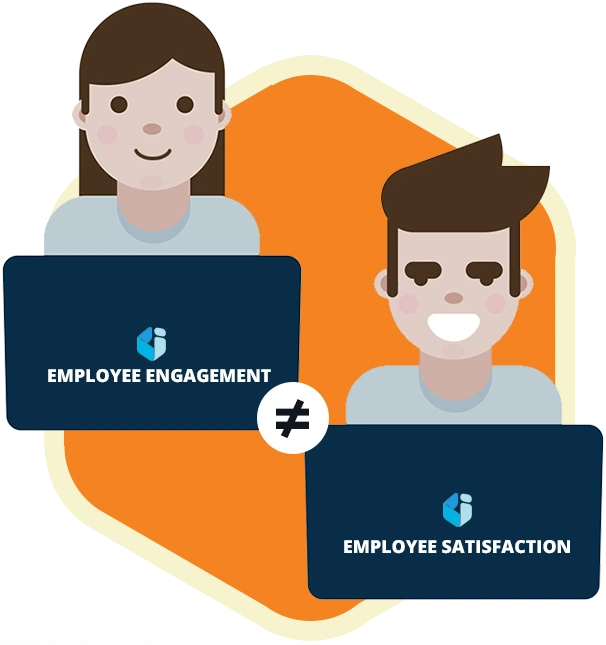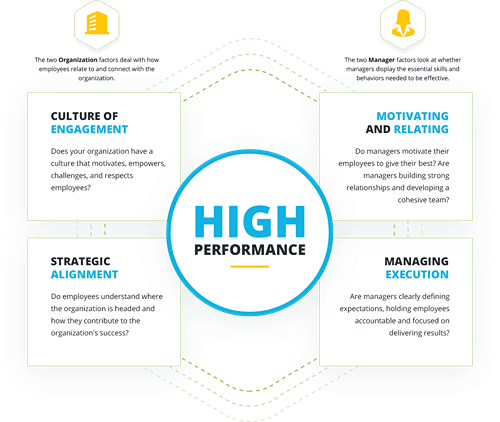
What is the meaning of Employee Engagement?
It is defined by the extent to which contributors feel passionate about their jobs, are committed to the organization, and put discretionary effort into their work.
This is not the same
as satisfaction
What is Employee Satisfaction?
It is defined by how happy or content your contributors are. It does not address their deeper level of motivation, involvement, or emotional connection to the organization. For some, being satisfied means collecting a paycheck while doing as little work as possible.
Job satisfaction is important for other reasons. It has an impact on a person's work lifecycle, affecting retention and turnover. This is especially true in situations where low satisfaction is due to low compensation.
When organizations focus on how to improve satisfaction, changes might not lead to increased performance. The conditions that make workers "satisfied" with their jobs can reveal ways to improve and challenge the status quo.


Understand Your Staff's Experiences
Increasing engagement isn't limited to perks, activities, or isolated initiatives. It is integrated throughout the lifecycle of a contributor, their experiences spanning from recruitment and the onboarding process to exit interviews. It includes how employees behave and think at work, how they engage in tasks, and how they collaborate with colleagues. It covers the entire employee experience. Shaped by daily interactions (and actions) at work, engagement is critical for maintaining sustained excellence.
What does that look like?
They seek feedback from management. They excel in communication. They expect everyone to be held accountable for delivering results. They find meaning in their team and at work. They express interest in chances for growth. They are innovative and comfortable with challenges. Conversely, low performers avoid accountability, cling to the status quo, and resist change.
The conditions that make some "satisfied" with their jobs are the same conditions that frustrate high performers.
Why is employee
engagement important?
It has a direct impact on business outcomes.
Engaged workers look at the whole of the company and understand their purpose. They understand where and how they fit in. This is called alignment. Alignment leads to better decision-making, which drives growth and innovation. Organizations with an engaged workforce outperform their competition. They have higher earnings per share (EPS). They recover more quickly after recessions and financial setbacks. They experience a reduction in absenteeism, less stress, and less burnout. These companies have more effective leadership and better customer satisfaction.
What are the benefits of employee engagement?
Increased productivity, creativity, innovation, employee retention, and loyalty.
Improved relationships, communication, collaboration, customer satisfaction, and organizational culture.
Reduced absenteeism and turnover costs.
These are just a few benefits of engaged workers. Successful companies are future-focused. They treat talent as scarcer than capital.

These statistics show the benefits of workforce engagement:
The impact of employee engagement on performance is visible in the net income of an organization.
Increases:
- 22% in Profitability
- 21% in Productivity
- 22% in Customer Ratings
Decreases:
- 41% in Quality Defect
- 48% in Safety Incidents
- 37% in Absenteeism
How to Increase Employee Engagement
We have over twenty years working with organizations. Our research and experience have led us to the conclusion that employee engagement is the outcome of deliberate and strategic practices deeply embedded in a company's culture. It is the result of everyday actions that build toward success. Begin by improving the employee experience. Key factors that improve company culture include belongingness, autonomy, accountability, communication, recognition, and opportunity.
Belongingness
Do not underestimate the power of belonging at work. Create a safe, inclusive work environment. People need to feel comfortable expressing themselves. Their contributions must have value. They should be confident in performing their roles. Build belonging at work and demonstrate commitment to it through meaningful benefits and initiatives. Organizations must have a structure that supports this.
Empowerment and autonomy
The degree of autonomy and self-governance someone has in decision-making, task execution, and role responsibilities determines these values. Empower your workers. Give them space to manage workloads and prioritize innovation and experimentation. Provide staff with opportunities and stretch tasks for personal growth.
Accountability
This is about delivering on commitment. When people are held accountable for their work, the organization establishes a culture of trust. There is an expectation that everyone will do their jobs. People, and organizations, succeed. Ideas to increase accountability include communicating clear expectations, identifying problem areas, handling disagreements with maturity and grace, and discussing professional and personal goals with personnel. Practice accountability. Make it a habit.
Communication
Strategic, multi-directional communication is part of a healthy organization culture. Successful internal communication increases teamwork and productivity. This improves the worker experience. Examples of internal communication strategies include one-on-one conversations, meetings, company emails, employee apps, and intranet forums. If it matters, measure it. Establish metrics to determine the effectiveness of the internal communication plan.
Recognition
Meaningful recognition and fair compensation matter. Acknowledge and reward staff for their contributions and achievements. Pay them well. Provide benefits that matter. Show gratitude. Types of recognition include bonuses, written thank you notes, verbal praise at a meeting, formal recognition (picking top performers), and tenure anniversaries. Publish achievements on community platforms, the organization website, and in a newsletter. Recognition helps people find meaning with their work and the organization.
Growth opportunities and talent development
Provide opportunities, activities, and programs for people to grow and learn. Great leaders know the personal and professional goals of everyone on their team. They find ways to align individual's goals with the mission of the organization. This not only improves the employee experience, but also attracts top talent. These are tangible benefits to the organization. Explore many ways to develop your teams. Bring in speakers and industry experts. Create a library area with relevant materials. Get your senior staff active and involved with mentorship and returnship programs. Provide employees with the chance to attend workshops, conferences, and online classes.
Best practices to boost engagement include developing strategies aimed at improving the worker experience. Engagement efforts must include sustainable programs, ideas, and initiatives. It boils down to data-driven decision making.
Assess the commitment, motivation, and perceptions people have of the company. Take a measurement of your organization's engagement levels. Identify what motivates and what disengages your people. Then make strategic decisions to improve your company culture and employee performance. Here's how.
How to measure employee engagement:
Surveys offer a data-driven and effective method to measure employee engagement. They measure contributors' performance, strategic alignment, competency, and satisfaction. Surveys are among the most effective tools for gaining a deeper understanding of a company's needs, providing employees with an opportunity to voice their opinions. A survey serves as a blueprint, helping the organization understand and identify both motivators and sources of disengagement. Survey results shed light on how human resources strategies impact business outcomes. This provides organizations with actionable insights that can drive informed decision-making. Implementing meaningful actions based on survey findings can positively impact company culture, improve safety, and well-being, among other things.
Measure what matters.
What is employee engagement software? Employee engagement software is a SaaS solution that serves as a platform for organizations to collect, analyze, and act upon feedback from contributors regarding different aspects of their work environment. Typically managed by human resources, this technology facilitates the execution of surveys, the recognition of achievements and high-performing teams, and the identification of areas for improvement. When selecting survey software, prioritize vendors offering easy implementation, meaningful analytics, relevant metrics, focus areas, best practices, and anonymity. Here are elements to look for in a survey software platform and keys to a successful survey process:
Benchmarking Data: Choose a statistically validated questionnaire with benchmarking metrics to assess and improve drivers of engagement in your company. These metrics provide valuable reference points for comparison with thousands of companies.
Hire an independent survey provider. This guarantees the objectivity and anonymity of the process. This builds trust.
Choose a survey that includes questions that cover a broader range of relevant topics. Short questionnaires can accurately measure engagement, but they can only provide an indication of whether contributors are engaged. Because they lack detail, they have a hard time detecting drivers of employee engagement or disengagement. This leaves organization leaders and HR with more questions. They will be unable to pin-point challenges the company, management, or specific departments face. Without sufficient information, an organization cannot develop strategies, create meaningful activities, design training programs, generate actionable ideas, and implement effective initiatives.
Include open-ended questions for deeper insights into potential problems. They allow people to share additional context, providing qualitative data for a more comprehensive feedback analysis. Combine these insights with quantitative survey data for a complete understanding.
Identify high-impact priorities. Prioritize actionable insights that can lead to tangible improvements for the worker experience. Define actions for improvement. Communicate actions to your teams. Implement sustainable changes. A survey is only effective when HR and organization leaders take the feedback and convert it into direct, meaningful actions. Do not ask if you are not going to act.
4 Steps to Take Action on Survey Results. Show your staff the importance of their feedback and time.
1. Analyze the data.
2. Identify the key drivers of both employee engagement and disengagement.
3. Prioritize. Focus on the areas that have the biggest impact on company culture.
4. Be strategic, plan activities, and implement sustainable initiatives and programs.
Track tendencies within your company. To do so, you need to have historical data relevant to the current outcomes. Choose a survey provider and software with a user-friendly platform that provides HR with analysis tools, graphics, and benchmark data. An effective survey can help your organization improve employee engagement with actions that count.


Employee Engagement Tools: What types of surveys are there?
There are many options to get meaningful feedback from your contributors. Identify high-performing teams and managers. Diagnose areas that need more development and attention. Measure your inclusion strategies. Assess the effectiveness of your organization. Get feedback on action plans that have been implemented. Choose from one of these solutions, depending on your organization's needs:
Employee Engagement Survey: Focal ORG
This is our flagship engagement survey. It measures the four key components that drive performance and can help you identify, understand, and fix problems in your organization.360 Degree Feedback
Our management evaluation survey is used as a development tool for organization leaders. This trusted assessment is used by more than half of the Fortune 100, as well as thousands of other companies worldwide.Pulse Surveys
These questionnaires are typically a shortened version of a more comprehensive annual survey process. Customizable, your team leaders can check in about ongoing changes and actions. Focus on areas that you consider the most important.DEI
Our new DEI opinion questionnaire is FREE OF CHARGE. It includes research-based questions, benchmarks, and an interactive dashboard. It can help give you insights and information about your organization culture. Identify opportunities for improvement. Actionable data can give you the keys to implement meaningful change.
Team Assessment Questionnaire
Effective teams are pivotal to the success of your organization. Identify strengths and weaknesses in your teams. Improve trust, skills, and team effectiveness with this evaluation tool.
The Suggestion Box
Focal BOX is an online suggestion box that enables people to share their anonymous feedback with you about anything anytime.
Custom Surveys
The online custom survey maker platform enables you to gather feedback to measure engagement, satisfaction, and much more. Create your customized survey, quickly and easily, and get measurable feedback about anything, anytime and anywhere.
The CustomInsight Engagement Blog:
We invite you to consult our blog for ways to turn insights and information into meaningful actions. Get the tools to improve morale and productivity with your workforce, learn about tendencies and trends in HR, and learn how to make employee engagement a strategy. Engage. Develop. Succeed.
Contact us to determine which solution is best for your organization.
When should an organization measure
employee engagement?
The best time to conduct an employee engagement survey is typically sooner rather than later.
Keep in mind that peak holiday seasons might reduce response rates. Also, conducting questionnaires during bonus periods or periods of high stress might skew your results either positively or negatively. The timing can influence the results in these situations. On the other hand, delay means not having a clear understanding of how engaged your people are. We can work with HR and management to determine optimal timing to implement the process.
Prepare for the
survey
Implementation Plan
Boost the effectiveness of your process
:The process is only as effective as the effort the organization, senior leaders, and teams put into action plans based on results to drive necessary changes.

What drives employee engagement?
In our flagship product, Focal Org, we provide your organization with the tools to measure the two primary factors that drive employee engagement. These factors are based on statistical analysis and widely supported by industry research. They are engagement with the organization and engagement with "my manager."
Engagement with
The Organization
This measures how engaged people are with the company as a whole, and by extension, how they feel about senior management. This factor has to do with confidence in organizational leadership as well as trust, fairness, values, and respect - i.e. how people like to be treated, both at work and outside of work.
Engagement with
My Manager
This is a more specific measure of how people relate to their direct supervisors. Topics include feeling valued, being treated fairly, receiving feedback and direction, and generally, having a strong working relationship based on mutual respect. Great managers regularly provide their team with feedback, support, and growth opportunities. This helps foster better connections with the organization.

Beyond the Two Core Factors
High performance organizations, and a highly engaged workforce, also excel in these areas:
Strategic Alignment
Does everyone have clarity of purpose and direction? Do they understand how the work they do contributes to the organization's success? Strategic alignment ensures people have clarity of purpose and direction, and that their efforts are focused in the right direction. If those efforts are not focused in the right direction, they could be wasted.
Managing Execution
The most effective managers excel not only at people skills, but they also provide clear expectations, hold people accountable, and stay focused on delivering results.
A survey measures some aspects of Leader and Manager Competency via upward feedback. For a more complete assessment of manager competency, we recommend using a 360 Feedback Survey.
See how to improve employee engagement

Who should be involved in employee engagement programs?
Results are in. Now what? Change needs to be embraced by the entire organization, but an effective employee engagement process begins with HR. HR can lead the charge, playing a critical role in ensuring the successful implementation of initiatives and programs. The worst your organization can do is nothing. Don't put the survey in a drawer until next year. Acting on results communicates that the ideas and perceptions of your teams matter.
There is often a clear gap between the perceptions and optimism of upper management and what middle and frontline managers experience with their teams. To understand the whole-organization picture, dig deep into survey results. Analyze them to better understand what is happening throughout the organization. A strategic internal communication strategy is key for the successful implementation of changes based on survey results.
Employee Engagement Strategies
It's common for people to mistakenly use "activity" and "strategy" as synonymous, but there's a critical distinction between the two. A strategy represents an evidence-based, systematic method for approaching a particular process. Your chosen strategy dictates the activities you decide to carry out and the actions your organization takes. In other words, strategy drives action. It's your overarching game plan. That said, strategy without execution is meaningless.
Employee Engagement Ideas
A strong engagement strategy leads to innovative ideas to maintain the motivation and dedication of people to both the company and individual roles. Several imaginative, budget-friendly ideas can enhance engagement. Ideas, based on your unique company culture, can promote wellness, build community, and shape organizational culture. Company leaders and HR must implement meaningful actions based on survey results. Ideas to increase engagement include wellness challenges, workshops led by contributors, mentoring circles, recognition platforms and more.
Employee Engagement Activities
Choose activities that support your strategy to increase employee engagement. Successful examples include team building workshops, volunteerism, wellness programs, hack-a-thons, workplace gamification, and office celebrations. Every action matters when it comes to improving your organization's culture and worker experience.
How to improve employee engagement
Begin with respect: respect for your workplace, your workforce, your peers, your stakeholders, your clients and customers.
7 powerful ways to achieve employee engagement, all with a baseline of respect, include strategic communication, recognition and rewards, purpose and meaning, empowerment and autonomy, personal and professional development, work-life balance, and inclusiveness and diversity.
Dignity and respect are not only the right things to embrace in your organization but also the smart things to embrace. They will improve the performance and commitment of your people.

Maintaining Employee Engagement
Maintaining employee engagement could be, quite possibly, the most strategic thing your organization can do. It is a continuous endeavor vital for a thriving workplace. It entails consistently fostering and strengthening the connection between employees, their roles, colleagues, and the organization.
There is a favorite quote attributed to Aristotle (though he didn't technically say it), and interpreted by Will Durant, "We are what we repeatedly do ... therefore, excellence is not an act, but a habit."
What are the Four Areas of Employee Engagement
The active involvement of people in their roles impact both individual and organization success. Understand the different ways your contributors connect with their work, workplace, and teams.
Emotional Engagement:
This refers to an employee's sense of connection to their work, colleagues, and the organization as a whole. It involves a deep sense of purpose and genuine enthusiasm for the tasks and work someone does. Highly emotionally engaged people are loyal, productive, and satisfied. They are committed to the mission and vision of the company. They have lower levels of absenteeism.Behavioral Engagement:
This is evident in an individual's actions and conduct in the workplace. It is about their dedication, commitment, and enthusiasm in achieving the organization's objectives. Workers who are behaviorally engaged meet or exceed performance targets. They are great collaborators. They hold themselves accountable for their work, admit to mistakes, and take actions to correct them.Cognitive Engagement:
This refers to the intellectual investment an employee makes in their work. It involves a high level of mental commitment and a readiness to go the extra mile. Cognitively engaged workers are innovative and problem-solvers. They seek ways to improve processes. They do not shy from challenges. And they consistently look for growth opportunities.Social Engagement:
Referring to the quality of an employee's interactions and relationships within the workplace, socially engaged workers are good with collaboration, communication, and feel a deep sense of belonging. They build a healthy team culture, are a mentor to peers and new hires, nurture strong working relationships, have a high sense of belongingness. They tend to have better mental health.The elements that drive employee engagement are usually similar across most companies, but the specific concerns and level of importance are unique and specific in every company and even in different demographic subgroups within a company.
We employ two techniques that help you identify what drives the most engaged employees in your company and to understand what to focus on and how to improve in those areas.
We look at the statistical patterns across all groups in your organization to determine which items are impacting overall engagement within each demographic group. Items with low scores that are strongly linked to commitment, performance, and involvement are the areas where you will want to focus your change initiatives and strategy.
Dig deeper. We ask targeted follow-up questions to get examples of problems as well as suggestions for how to improve them. After pinpointing priorities and areas that need improvement, turn to the comments for detailed insights on the what, why, and how. Analyze feedback and comments. Identify priorities, focusing on high-impact areas. Take action. Meaningful actions depend on effectively interpreting survey results.
What is employee disengagement? Identify Pockets of Discontent
Disengagement is characterized by its symptoms: slow work (and missed deadlines), low attendance to meetings, increased absenteeism, carelessness, distracted and apathetic employees. Surveys can identify "at-risk" demographic groups within your company.
What has the biggest impact on employee disengagement?
Our research and collaboration with organizations over the past 25 years have brought us to the same conclusion to that question. Managers, immediate supervisors, organization leaders (all of the above) are the single biggest variable when it comes to disengagement.
Successful managers value and recognize the contributions of their team. They clearly define goals and expectations. They prioritize collaboration and team performance. They hold their team (and themselves) accountable. They give their teams the freedom to do their jobs. They provide timely, candid, and kind feedback. They provide growth opportunities. The impact of great managers on your organization is tangible.
Is employee disengagement a problem with high-performing organizations? Even companies with high overall levels of engagement will have areas that are struggling. These problem areas can have a big impact on company performance, with high levels of localized turnover and apathy. We call them "pockets of discontent."
Understanding what is happening in these different demographic groups within your organization is at least as important as the overall level of engagement.
When you find an at-risk group, you can quickly drill down and look at the specific issues and dynamics within that group. This is important, not only for the wellbeing of your company culture but also for your bottom line. According to Gallup's State of The Global Workplace:2022 Report, disengagement cost the world 7.8 trillion dollars in lost productivity. How much is disengagement costing your organization?

